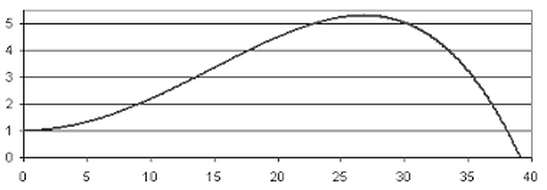Physics Behind the Frisbee Throw
As one may assume, there is a lot to be said about what makes a properly thrown frisbee fly. Gravity, for starters, plays a huge role. For many people out there, gravity is not something that is taken into the days many thoughts (although all-in-all it plays a huge part in the majority of ones day). Gravity, in terms of an object on earth, is the attraction of an object to the earths center. The fact that objects fall to the ground when nothing is supporting them is due to gravity.
For a frisbee to fly through the air it must have enough of a force applied to 'overcome' gravity for a certain amount of time. This force is created by a players throw. A simple flick of the wrist. If the frisbee needs to go a longer distance, the throw must have more force to counteract gravity for a longer period of time (Aparicio, 2). A shorter throw will take less force.
But, that said, just because a frisbee has a lot of force behind it does not mean that it will go a long distance! This is where technique is required.
But, that said, just because a frisbee has a lot of force behind it does not mean that it will go a long distance! This is where technique is required.
Consider trying to throw a frisbee by pushing it horizontally away from you. This is not effective! The frisbee simply falls to the ground--even if there is a strong force being applied.
As the diagram above depicts, frisbees are made to spin. One of the key elements of throwing a frisbee is the flick of the wrist just before the release. This has to do with gyroscopic force: "the tendency of a spinning object to maintain a stable orientation" (AMomentofSciencePBS ). Think about a general table top spinner.
Spin is important, but so is the angle. Think about throwing a frisbee flat. The frisbee will fly at an angle slowly downwards. This is because of that idea of gravity. Gravity is pulling the frisbee downwards towards the ground. To achieve a throw with distance, the frisbee must be aimed at an angle upwards to counteract the force of gravity for a longer period of time.
As the diagram above depicts, frisbees are made to spin. One of the key elements of throwing a frisbee is the flick of the wrist just before the release. This has to do with gyroscopic force: "the tendency of a spinning object to maintain a stable orientation" (AMomentofSciencePBS ). Think about a general table top spinner.
Spin is important, but so is the angle. Think about throwing a frisbee flat. The frisbee will fly at an angle slowly downwards. This is because of that idea of gravity. Gravity is pulling the frisbee downwards towards the ground. To achieve a throw with distance, the frisbee must be aimed at an angle upwards to counteract the force of gravity for a longer period of time.
Wind resistance is also something that must be taken into account here. As human beings, we are quite used to the fact that there is constantly air all around us that actually slows down our motion (especially when trying to move at a higher speed). Frisbees are not only slowed down by gravity but by air resistance as well. This is the idea of drag, or friction, between the air and the frisbee.
As discussed later on, frisbees are shaped the way that they are to reduce the amount of surface area, and thus the amount of drag.
As discussed later on, frisbees are shaped the way that they are to reduce the amount of surface area, and thus the amount of drag.


